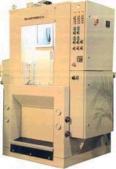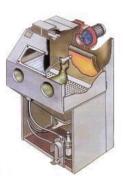Safety
 Introduction
Introduction
Mainly in the development of material equipment, they have incorporated a wide range of devices that ensure efficient protection for operators and the environment.
In manual or automatic cabinets, the blasting and operator are in separate environments and the main protection comes down to sight glasses, gloves or curtains and brushes in the inlet and outlet tunnels of parts.
It is supplemented by the presence of hoods that cause internal pressure relief in the gun areas to prevent abrasive and dust leakage in case of sealing failures.
 A number of optional devices have been developed to increase operator safety:
A number of optional devices have been developed to increase operator safety:
a) Locking systems for gun operation when any door or opening is improperly closed;
b) Pneumatic systems that prevent the doors from opening, only releasing them 30 seconds after the pistols have been turned off, allowing time for the total settling of the dust, preventing its leakage or being absorbed by the operator;
c) For automatic equipment, several electro-mechanical devices have been designed that instantly shut down the system in case of an accident or when the operator inadvertently reaches dangerous areas;
(d) In appliances where the movement of certain parts is hazardous, light or audible alarms which operate during the displacement phase shall be fitted.
and) Two-hand controls, just like presses, are also widely used.
The dry blasting process naturally generates more or less dust, which has to be captured so as not to disperse in the environments, damaging men and machines.
a) All dry jet enclosures are supplied with dust collectors. The simplest are fabric balloons or multifilters mounted after the hoods (positive pressure). However, the need to shake them periodically for cleaning causes a small amount of dust to come off contaminating the environment. A more efficient system is to close the filters, usually made up of multiple sleeves or cartridges, into a tightly sealed metal box, attached to the cabinet and with the hood mounted after the box, sending filtered air into the atmosphere. This solution achieves desirable negative pressure not only in the cabinet but also in the manifold. Even more if the hood outlet is connected to the exterior or central ventilation systems, the protection is complete, even against possible maintenance failures.
(b) Abrasive dust collection and recycling systems shall be connected in a certain order to prevent dust accumulation and leakage.
As a solution, the electrical control panels are designed with sequential locks that even prevent the operation of the nozzles or guns, if not completed.
c) Special mufflers are designed for mounting in part inlet and outlet tunnels or exhaust hoods to reduce noise to acceptable levels.
d) In cases where the presence of dust is critical, more sophisticated filters may be provided, usually operating in the presence of water.
 For open pit or cabin work where pressure jet machines are generally employed, the safety problems are very large.
For open pit or cabin work where pressure jet machines are generally employed, the safety problems are very large.
a) The first concern should be the quality of air breathed by the operator, especially when using sand as an abrasive because it causes silicosis. Filtering masks are totally inadequate because they are evidently porous, always allowing fine dust particles to pass through and exactly located in the pulmonary alveoli.
Air must be captured outside the work environment and injected into the helmets after filtration. The solution is to use the compressed air and pass it through a purifier, provided with pressure regulator and pressure gauge and with five stages of filtration.
b) For the protection of the player, a whole line of materials was developed, such as fiber helmets with shields, light but resistant jackets, gloves, aprons, leggings, etc.
c) By attaching a jet nozzle without being firmly secured, it whips violently offering double danger: it can hit the operator or hit him directly with the jet. It is recommended to use the remote control of the jet machine by means of a trigger operated by the jet driver himself near the nozzle. If he releases the hose, the system automatically shuts down.
 Finally, with regard to cabs, adequate safety devices have been developed to fulfill all anticipated and adaptable cabinet functions already reported, as well as special protected luminaires ensuring good lighting, peephole for inspection and complete ventilation systems. horizontal to drag suspended dust across the cab area.
Finally, with regard to cabs, adequate safety devices have been developed to fulfill all anticipated and adaptable cabinet functions already reported, as well as special protected luminaires ensuring good lighting, peephole for inspection and complete ventilation systems. horizontal to drag suspended dust across the cab area.
Protecting your assets and the health of your employees is the duty of every responsible. For this reason, the “blasting” solution is sometimes considered a necessary evil and deployed as far away as possible. It is hoped that this report will help to somehow confirm the image of an efficient and even irreplaceable industrial process in many applications.
-
Phone
+55 (11) 3388-3534
-
Rua Muniz de Souza, 306
Aclimação, São Paulo - SP
-
E-mail:
zirtec@zirtec.com.br
